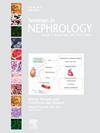求助PDF
{"title":"基因-环境相互作用:补体介导肾病的经验教训。","authors":"Nattawat Klomjit, Jing Miao, Anuja Java","doi":"10.1016/j.semnephrol.2025.151657","DOIUrl":null,"url":null,"abstract":"<p><p>Atypical hemolytic uremic syndrome (aHUS) or complement-mediated thrombotic microangiopathy (CM-TMA) and C3 glomerulopathy are two prototypical diseases of complement dysregulation occurring due to genetic variants in complement proteins or acquired factors such as autoantibodies. Despite the presence of an underlying genetic etiology, an environmental trigger is often necessary to manifest disease, a phenomenon known as incomplete penetrance. These triggers could include infections, pregnancy, medication, cancers, or ischemia-reperfusion injury and antibody-mediated rejection in the setting of transplantation and highlight the complex interplay between genetic etiology and environmental factors. Other diseases in which complement activation may also be a part of the underlying pathophysiology and where the gene-environment interaction also plays out are IgA nephropathy, lupus nephritis, ANCA-associated vasculitis, and membranous nephropathy. Genetic polymorphisms and haplotypes may further skew the balance between complement over activation and control. In this article, we discuss the activation and regulation of the complement system and the role of complement in various kidney diseases. We also attempt to provide an in-depth understanding of the genetic drivers and environmental triggers associated with complement activation using aHUS as a key example. Semin Nephrol 36:x-xx © 20XX Elsevier Inc. All rights reserved.</p>","PeriodicalId":21756,"journal":{"name":"Seminars in nephrology","volume":" ","pages":"151657"},"PeriodicalIF":3.5000,"publicationDate":"2025-07-01","publicationTypes":"Journal Article","fieldsOfStudy":null,"isOpenAccess":false,"openAccessPdf":"","citationCount":"0","resultStr":"{\"title\":\"Gene-Environment Interaction: Lessons From Complement-Mediated Kidney Disease.\",\"authors\":\"Nattawat Klomjit, Jing Miao, Anuja Java\",\"doi\":\"10.1016/j.semnephrol.2025.151657\",\"DOIUrl\":null,\"url\":null,\"abstract\":\"<p><p>Atypical hemolytic uremic syndrome (aHUS) or complement-mediated thrombotic microangiopathy (CM-TMA) and C3 glomerulopathy are two prototypical diseases of complement dysregulation occurring due to genetic variants in complement proteins or acquired factors such as autoantibodies. Despite the presence of an underlying genetic etiology, an environmental trigger is often necessary to manifest disease, a phenomenon known as incomplete penetrance. These triggers could include infections, pregnancy, medication, cancers, or ischemia-reperfusion injury and antibody-mediated rejection in the setting of transplantation and highlight the complex interplay between genetic etiology and environmental factors. Other diseases in which complement activation may also be a part of the underlying pathophysiology and where the gene-environment interaction also plays out are IgA nephropathy, lupus nephritis, ANCA-associated vasculitis, and membranous nephropathy. Genetic polymorphisms and haplotypes may further skew the balance between complement over activation and control. In this article, we discuss the activation and regulation of the complement system and the role of complement in various kidney diseases. We also attempt to provide an in-depth understanding of the genetic drivers and environmental triggers associated with complement activation using aHUS as a key example. Semin Nephrol 36:x-xx © 20XX Elsevier Inc. All rights reserved.</p>\",\"PeriodicalId\":21756,\"journal\":{\"name\":\"Seminars in nephrology\",\"volume\":\" \",\"pages\":\"151657\"},\"PeriodicalIF\":3.5000,\"publicationDate\":\"2025-07-01\",\"publicationTypes\":\"Journal Article\",\"fieldsOfStudy\":null,\"isOpenAccess\":false,\"openAccessPdf\":\"\",\"citationCount\":\"0\",\"resultStr\":null,\"platform\":\"Semanticscholar\",\"paperid\":null,\"PeriodicalName\":\"Seminars in nephrology\",\"FirstCategoryId\":\"3\",\"ListUrlMain\":\"https://doi.org/10.1016/j.semnephrol.2025.151657\",\"RegionNum\":3,\"RegionCategory\":\"医学\",\"ArticlePicture\":[],\"TitleCN\":null,\"AbstractTextCN\":null,\"PMCID\":null,\"EPubDate\":\"2025/7/16 0:00:00\",\"PubModel\":\"Epub\",\"JCR\":\"Q2\",\"JCRName\":\"UROLOGY & NEPHROLOGY\",\"Score\":null,\"Total\":0}","platform":"Semanticscholar","paperid":null,"PeriodicalName":"Seminars in nephrology","FirstCategoryId":"3","ListUrlMain":"https://doi.org/10.1016/j.semnephrol.2025.151657","RegionNum":3,"RegionCategory":"医学","ArticlePicture":[],"TitleCN":null,"AbstractTextCN":null,"PMCID":null,"EPubDate":"2025/7/16 0:00:00","PubModel":"Epub","JCR":"Q2","JCRName":"UROLOGY & NEPHROLOGY","Score":null,"Total":0}
引用次数: 0
引用
批量引用

 求助内容:
求助内容: 应助结果提醒方式:
应助结果提醒方式:


